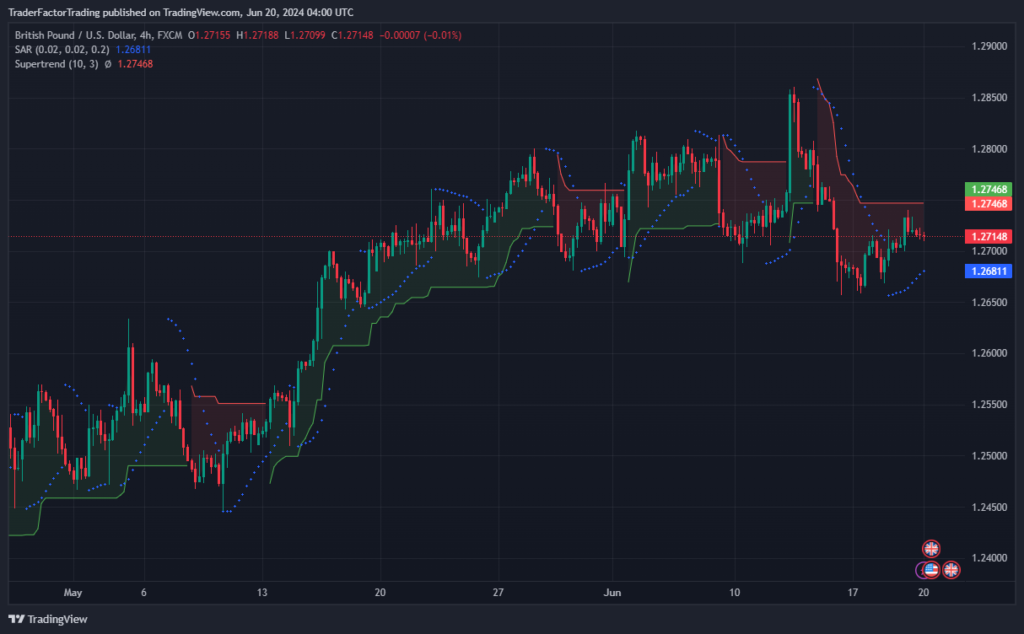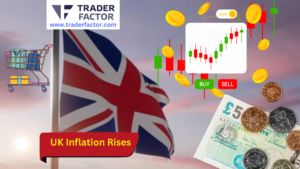Traders are closely waiting for the Bank of England rate decision, where they’re expected to hold interest rates steady at 5.25%. With inflation hitting the 2% target, economists and traders anticipate this decision will continue to balance economic stability with growth. High borrowing costs remain a concern, closely influencing mortgage payments and business investments. As you plan your trades, understanding the nuances of these economic indicators could prove essential. Engaging further reveals how these decisions affect market expectations and your financial planning.
GBP/USD Rises Above 1.2700 Ahead of Bank of England Rate Decision
The GBP/USD pair nudged its way firmly above the 1.2700 mark in subdued Wednesday trading. The US midweek holiday resulted in reduced market volumes, dampening trading flows. As the Bank of England (BoE) gears up for its latest decision on Thursday, expectations are for rates to remain unchanged at 5.25%. Investors will be closely watching for any shifts in voting patterns, though recent UK economic data, while underwhelming, hasn’t been poor enough to incite fears of a recession.
GBPUSD 4-hour Chart

Background Overview
To fully grasp the current economic scenario, it’s important to understand how the Bank of England typically uses interest rates to manage inflation. By adjusting these rates, the Bank influences monetary policy to maintain economic stability. You’ve seen how interest rates serve as a lever to control market dynamics, balancing spending and saving to keep inflation trends within acceptable limits.
Currently, with inflation hitting a precise 2% target, the Bank of England Rate decision appears effective. This rate is vital as it aligns with the Bank’s goal to stabilize purchasing power and mitigate cost-of-living increases. When inflation deviates from this target, it prompts a reassessment of monetary policy. The recent drop from 2.3% to 2% in May suggests that previous rate adjustments are beginning to influence the economy as intended.
There is a delicate balance between promoting growth and controlling inflation. Keeping interest rates steady in this situation supports market confidence and guides expectations towards sustained economic health. The Bank’s decisions impact everything from mortgage rates to business investments, showing how deeply monetary policy is intertwined with everyday economic activities and financial planning. By closely monitoring these elements, the Bank aims to anticipate economic turbulence and maintain a stable financial environment.
UK Borrowing Costs
Despite the Bank of England‘s expected decision to maintain interest rates at 5.25%, borrowers might not see any relief as inflation remains a pressing concern. As you know, when interest rates stay high, your borrowing costs do too. This isn’t just about the numbers; it affects your mortgage payments, business loans, and even credit card rates. It’s a tightrope walk for the Bank of England, balancing inflation control with economic stability.
You might think that with inflation hitting the 2% target, a rate cut could be on the horizon, promising some respite. However, the economic landscape isn’t that straightforward. Despite this benchmark achievement, borrowing trends haven’t eased as might be expected. Economists, policymakers, traders, and the market observers, are caught in a web of anticipation about how long these rates will persist.
This scenario isn’t just a financial statistic; it’s a lived experience for millions. Your decisions on spending, investing, and saving are all influenced by these figures. The market reactions to these rates are a mix of resignation and cautious optimism, reflecting the complex interplay of global economic pressures and domestic fiscal policies. Remember, the broader impact of these rates extends beyond the immediate financial metrics to touch everyday economic activities and long-term plans.
Impact on Consumer Prices
Inflation’s recent drop to 2% in May means we might see changes in consumer prices, impacting how much consumers pay for groceries and utilities. This shift might feel like a slight reprieve as they manage their household budgets. However, don’t expect all prices to plummet. The landscape of price fluctuations is intricate, influenced deeply by broader economic impact and inflation trends.
While some costs might stabilize, others could remain high due to long-term trends affecting the market. This situation places a nuanced burden on consumer spending, as they might adjust priorities based on what’s more affordable at the moment. For instance, if utility costs dip but food prices soar, consumer may reallocate funds to cover essential needs, which in turn affects their overall spending habits and investments.
Understanding these dynamics is vital. The ripple effects of inflation and its control through interest rates by the Bank of England directly touch their day-to-day life. Staying informed helps you better navigate through these economic waters, ensuring you can adjust and plan your trades.
Economists’ Perspectives
Understanding how economists view the recent inflation trends can help you anticipate future financial, decisions, especially when you’re considering investments. Most experts agree that while the Bank of England‘s current stance seems to favor holding rates steady, the underlying inflation trends and economic stability are key factors influencing their decisions. Economists are closely watching these trends, as any shift could signal changes in future interest rate decisions.
Rate cut possibilities remain on the table, though most believe they won’t materialize immediately. The committee dynamics within the Bank’s Monetary Policy Committee play a significant role here. With inflation hitting the target recently, the expectation was for potential easing of rates. However, the persistent services inflation, which remains higher than anticipated, suggests that cuts might not be as imminent as some hope.
For you, this means keeping an eye on announcements and understanding that economic stability is a priority for policymakers. Decisions won’t be made hastily and will consider long-term implications. So, while you might hear speculations about rate cuts, remember that these are influenced by multiple factors, including inflation trends and committee perspectives, which aim to safeguard sustained economic health.
Bank of England’s Decision
How will the Bank of England’s decision to maintain interest rates at 5.25% impact your forex trading? Well, it’s important to take into account a few key aspects. First, the BoE’s independence means it’s not swayed by political pressures, focusing solely on economic data. This decision underscores their commitment to rate stability and inflation control. By keeping rates steady, they’re signaling confidence in the current economic strategies despite ongoing pressures.
For consumers, this means mortgage and loan rates won’t increase for now, which can be a relief if they are juggling various repayments. However, the economic impact of sustained rates can be a double-edged sword. It helps with planning stability but remember, the goal is to keep inflation at bay, which directly affects the cost of living.
Market response from the Bank of England rate decision has been cautiously optimistic. Investors and financial analysts see this move as a sign of a deliberate, data-driven approach by the BoE, aiming for long-term economic health over short-term gains. Keep an eye on how this decision plays out with consumer prices and employment rates, as these will be the real indicators of whether holding the rate was the right move.
Market Expectations
While the Bank of England‘s decision to hold rates steady reflects confidence in current economic strategies, market expectations are keenly set on how these policies will continue to influence financial stability and consumer prices. You’re likely wondering how this rate stability will play out in markets and what it means for your investments.
Market response to the Bank of England rate decision impact has been a mix of important optimism and strategic adjustments. Traders and investors are tuning in, analyzing every word from the Bank for hints about the future economic outlook. They’re not just passive observers; their reactions can swing markets significantly.
You should keep an eye on inflation analysis. Though the rate is steady now, any sign of inflation moving away from the target could prompt a swift policy change. This isn’t just about numbers; it’s about consumers cost of living and purchasing power. The current stability offers a buffer, but it’s fragile, hinging on numerous global and local economic shifts.
Understanding the complexity of these dynamics is important. Rate stability doesn’t just mean everything stays the same. It’s a delicate balance, maintaining enough stimulus to support growth while guarding against runaway inflation that could erode economic gains.
Comparative Analysis
In comparing the Bank of England‘s decision to hold interest rates steady with the ECB’s recent rate cuts, it’s clear that different economic conditions are steering monetary policies in diverse directions across Europe. You’ve got to look at the inflation comparison to understand the central bank strategies. While the UK’s inflation hit a target of 2%, the Eurozone’s lingered at 2.6% in May. These numbers are critical economic indicators that influence the interest rate dynamics.
Central banks use these indicators to tailor their approaches: the Bank of England Rate decision aims to manage inflation effectively without stifling growth, whereas the ECB’s cuts might be trying to spur economic activity amidst slightly higher inflation.
There is a cautious, measured approach from the Bank of England Rate decision, likely because they’re wary of rocking the boat too much in a stable economic environment. On the other hand, the ECB appears more aggressive, possibly to combat lingering economic challenges post-pandemic. Both strategies reveal a lot about the economic outlooks and fiscal health within each region.

Disclaimer:
All information has been prepared by TraderFactor or partners. The information does not contain a record of TraderFactor or partner’s prices or an offer of or solicitation for a transaction in any financial instrument. No representation or warranty is given as to the accuracy or completeness of this information. Any material provided does not have regard to the specific investment objective and financial situation of any person who may read it. Past performance is not a reliable indicator of future performance.
Author
-

Phyllis Wangui is a Financial News Editor with extensive knowledge of the forex, stock news, stock market, forex analysis, cryptos and foreign exchange industries. Phyllis is an avid commentator on these topics and loves to share her insights with others through financial publications and social media platforms.
View all posts SEO Editor

















